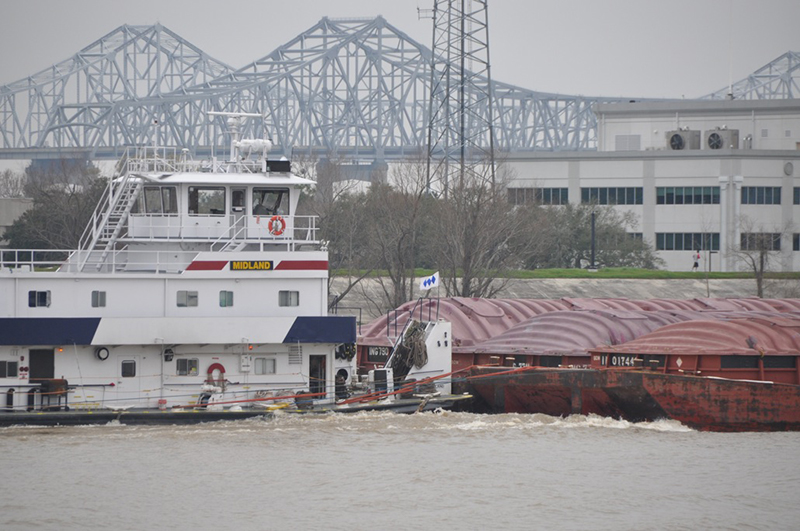Seven years overdue, legislation that sets a new strategy for funding and improving the U.S.’s aging inland waterways system now faces a final vote in Congress and then presidential signature before becoming law.
Congressional negotiators reached a long-awaited agreement late last week on the Water Resources Reform and Development Act of 2014 (WRRDA) and sent their conference report that details the sweeping changes to the House and Senate, which are expected to approve it later this week.
The last water policy reform law was passed in 2007, even though Congress is supposed to renew it every two years.
Passage of WRRDA has been a top legislative priority in Washington for the waterways, environmental and agriculture communities as the nation’s crumbling infrastructure and outmoded policies for dealing with it have complicated transportation of goods and services, caused costly delays, and been a drag on the national economy.
For the inland barge and towing industry, this was a must-do bill, as it makes changes that will free up money for completion of more waterways projects, reform the funding mechanism used to pay for projects, do a better job of prioritizing projects and put projects on strict schedules and oversight to make sure they are done on budget and on time.
The bill also takes federal water policy in a new direction by encouraging more private sector partnerships and investments that lawmakers hope will quicken the pace of projects and create more efficient management of them. And, in another important change, it increases the likelihood for more funding for harbor maintenance and dredging.
“This critical bill, that we urge President Obama to sign into law, will create American jobs, increase exports, keep our nation competitive in world markets, and enhance the ability of the nation’s waterways transportation mode,” said Michael Toohey, president/CEO of the Waterways Council, an industry-supported advocacy group. “The outlook for our inland waterways is very bright,” he added.
U.S. ports, soybean farmers and other industries that use the waterways to carry their products also praised the conference report as a much-needed way forward.
Key elements of WRRDA include the following:
• Direct the federal government to pay for more of the costs of the over-budget, behind-schedule Olmsted Lock and Dam project along the Ohio River in Illinois. The project’s costs have ballooned from $775 million to $3.1 billion, a 400 percent cost overrun. Olmsted is currently 50 percent funded by a diesel fuel tax paid by barge companies into the Inland Waterways Trust Fund, and 50 percent from the general treasury. The bill would increase Uncle Sam’s responsibility to 85 percent, dropping the barge company portion to 15 percent. This would free up about $105 million a year from the Fund to support other priority inland projects and reduce the current backlog of projects.
• Prioritize projects, based upon risk of failure and economic benefit to the country.
• Require on-time and on-budget performance by the Corps of Engineers in delivering water resource projects;
• Authorize new navigation channel improvements, and de-authorize some $18 billion of old, inactive water projects;
• Establish a pathway to full use of the Harbor Maintenance Tax (HMT) by 2025. The Harbor Maintenance Tax Fund was created in 1986 to finance harbor and channel dredging, but over the years, only about half of those funds generated from a tax on imports have been used for harbor projects. Supporters say full funding is critical as the expansion of the Panama Canal will bring larger ships to trade in U.S. ports.
• Examine use of public-private partnerships and bonding as alternate funding sources for waterways projects.
• Allocate 10 percent of the annual HMTF to “underserved, emerging ports” that handle less than one million tons a year to help them improve their harbors and competitiveness. Inland ports that meet this tonnage requirement could qualify.
• Strengthen dam and levee safety.
To further shore up the Inland Waterways Trust Fund, the industry is also seeking a nine-cent per gallon increase in the current 20-cent barge diesel fuel tax. This was not included in WRRDA but is being considered as part of a comprehensive national tax reform package proposed by the House Ways and Means Committee.
Toohey said the diesel tax increase, along with the IWTF revenues, is crucial to the funding of river infrastructure projects, many of which have been either stalled or slowed because money has gone to Olmsted. He said the tax increase has widespread support from waterways user groups and “nobody has spoken in opposition to this.” Tax bills take time to work through Congress, however, so it could be a while before new revenues are available for some inland projects, he acknowledged.
WRRDA is an authorization bill that sets federal policy. After it becomes law, the next big step will be more contentious — finding the funds to pay for these projects and reforms.
Toohey said he’s optimistic that Congress will go along, given approval last year of increased funding for waterways construction projects and operation and maintenance programs, in anticipation of WRRDA passage.




